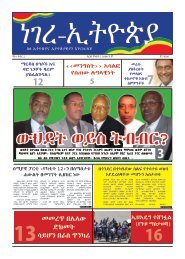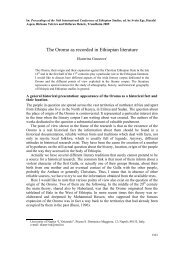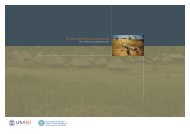MatabelelandReport
MatabelelandReport
MatabelelandReport
You also want an ePaper? Increase the reach of your titles
YUMPU automatically turns print PDFs into web optimized ePapers that Google loves.
In our review of the research and clinical studies, it became apparent that some clear categories emerge, both for types<br />
of violence and types of effects. We will describe these categories below in some detail.<br />
B.FORMS OF ORGANISED VIOLENCE<br />
It has become conventional in the study of organised violence to view violence as a kind of stress, albeit a very extreme<br />
form of stress. Where man-made stress is concerned, war, torture, riots, and psychological terror are sometimes<br />
considered to occupy a very similar position on the stress dimension. Despite their similarity, it is worth specifying the<br />
various forms, for, although the intent behind the violence may be the same - to deliberately harm human beings - the<br />
effects found are by no means uniform.<br />
Organised violence can be very simply classified into six main kinds:<br />
1. Physical torture.<br />
2. Deprivation.<br />
3. Sensory overstimulation.<br />
4 Psychological torture - general<br />
5. Psychological torture - Witnessing of death or torture.<br />
6. Psychological torture - "Disappearing" of people.<br />
These are by no means exclusive categories: it is usually not possible to separate clearly physical and psychological<br />
torture, except in the rare cases of psychological torture occurring in the absence of physical torture. It is fair to say that<br />
physical torture is always accompanied by verbal threats. In addition, people can suffer several types of physical torture<br />
simultaneously. A person might have been tortured, both physically and psychologically, have seen this happen to<br />
others, and have had a member of her family forcibly abducted and never seen again. Certainly, most interviewees<br />
providing data for this report suffered multiple types of abuse, as will be clearly illustrated by the cases used below.<br />
A seventh category, wounds due to war, might also have been included, for these will clearly be found amongst people<br />
from Matabeleland and other victims of war, but this category is so obvious in its origin and its effects that it requires<br />
little discussion. Unfortunately, bullet wounds, or limbs missing due to land mine explosions are all too often the only<br />
pathology examined by a society. Here we would point out that the First National Disability Survey, carried out in the<br />
early 1980's, is a good example of this point: injuries due to war are reported exclusively as physical injuries. We will<br />
thus concentrate on the original six areas.<br />
1.PHYSICAL TORTURE<br />
All methods of physical torture have the common element of causing extreme pain in a position of complete<br />
helplessness. This can be illustrated by a simple example in the difference between being hit by fists and boots in a<br />
fight as compared with being hit by fists and boots whilst being tied up.<br />
Although it is generally futile to attempt any classification of types of physical torture, since man's creativity in this area<br />
seems to know no limits, the range of types may be illustrated by reference to the findings from an international study<br />
on torture victims (Rasmussen.1990).<br />
TABLE 1<br />
TYPES OF PHYSICAL TORTURE (from Rasmussen. 1990)<br />
Beating 99%<br />
Severe beating 97%<br />
Severe beating (head) 73%<br />
Electrical torture 54%<br />
Physical exhaustion 34%<br />
Climatic stress 33%<br />
Asphyxiation 29%<br />
Falanga 29%<br />
Severe beating (genitals) 20%<br />
Submarine ("wet") 19%<br />
91







